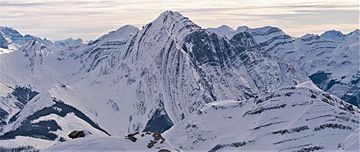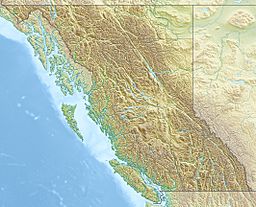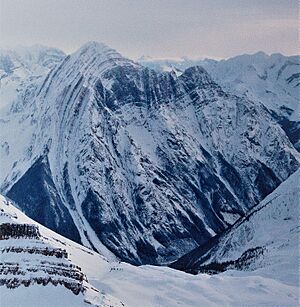Arras Mountain facts for kids
Quick facts for kids Arras Mountain |
|
|---|---|

Northwest aspect in winter
|
|
| Highest point | |
| Elevation | 3,090 m (10,140 ft) |
| Prominence | 1,699 ft (518 m) |
| Isolation | 3.4 mi (5.5 km) |
| Parent peak | Valenciennes Mountain (3,150 m) |
| Listing | Mountains of British Columbia |
| Geography | |
| Location | Kootenay Land District British Columbia, Canada |
| Parent range | Canadian Rockies |
| Topo map | NTS 82N/14 |
| Geology | |
| Age of rock | Cambrian |
| Type of rock | sedimentary rock |
| Climbing | |
| Easiest route | Mountaineering |
Arras Mountain is a tall mountain in the Canadian Rockies of British Columbia, Canada. It stands about 3,090-metre (10,138 ft) high. You can find it in the Kootenay Land District, near where Icefall Brook meets the Valenciennes River. It's also close to Rostrum Peak and Valenciennes Mountain.
The mountain was named in 1921. This name honors a very important battlefield in World War I at Arras, France. Canadian soldiers fought bravely there in 1917 and 1918. The name was officially accepted in 1924 by the Geographical Names Board of Canada.
What is Arras Mountain Made Of?
Arras Mountain is made of sedimentary rock. This type of rock formed over millions of years from tiny bits of sand, mud, and shells that settled at the bottom of ancient shallow seas. Over time, these layers hardened into rock.
Later, during a huge mountain-building event called the Laramide orogeny, these rock layers were pushed up and folded. If you look at the northwest side of the mountain, you can clearly see these rock layers tilted almost straight up! The mountain rises more than 2,000 meters (about 6,500 feet) from Icefall Brook in a very short distance, which shows how steep and dramatic the landscape is.
Weather Around Arras Mountain
Arras Mountain is in a subarctic climate zone. This means it has very cold and snowy winters. Summers are usually mild. Temperatures can drop below −20 °C (which is −4 °F), and with the wind, it can feel even colder, sometimes below −30 °C (−22 °F). The snow and rain that fall on the mountain eventually drain into Icefall Brook and the Valenciennes River.




